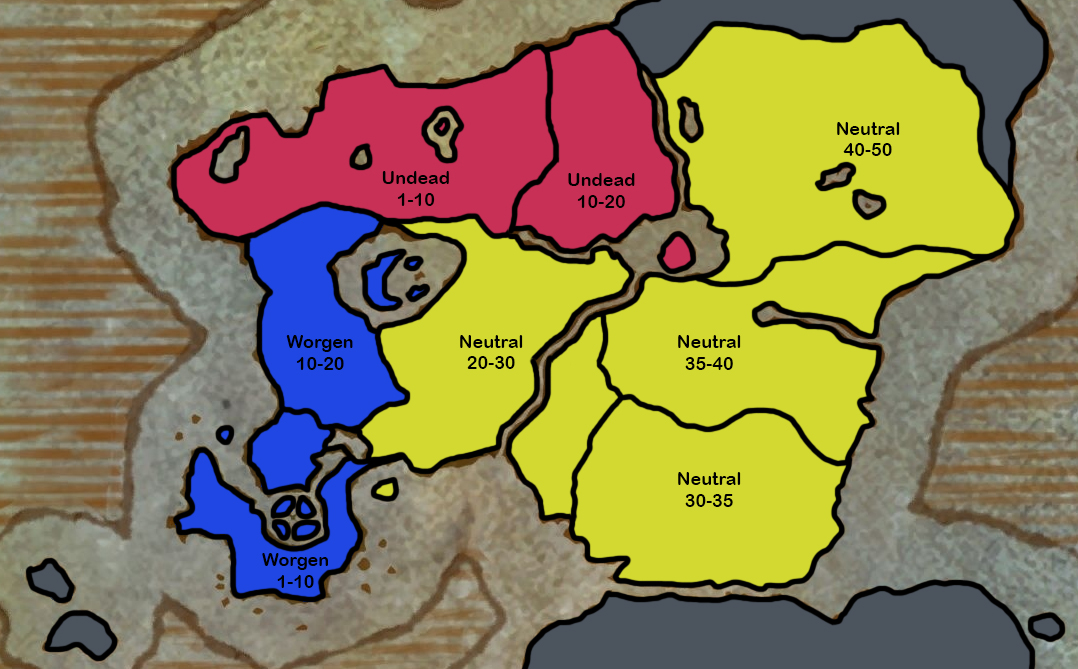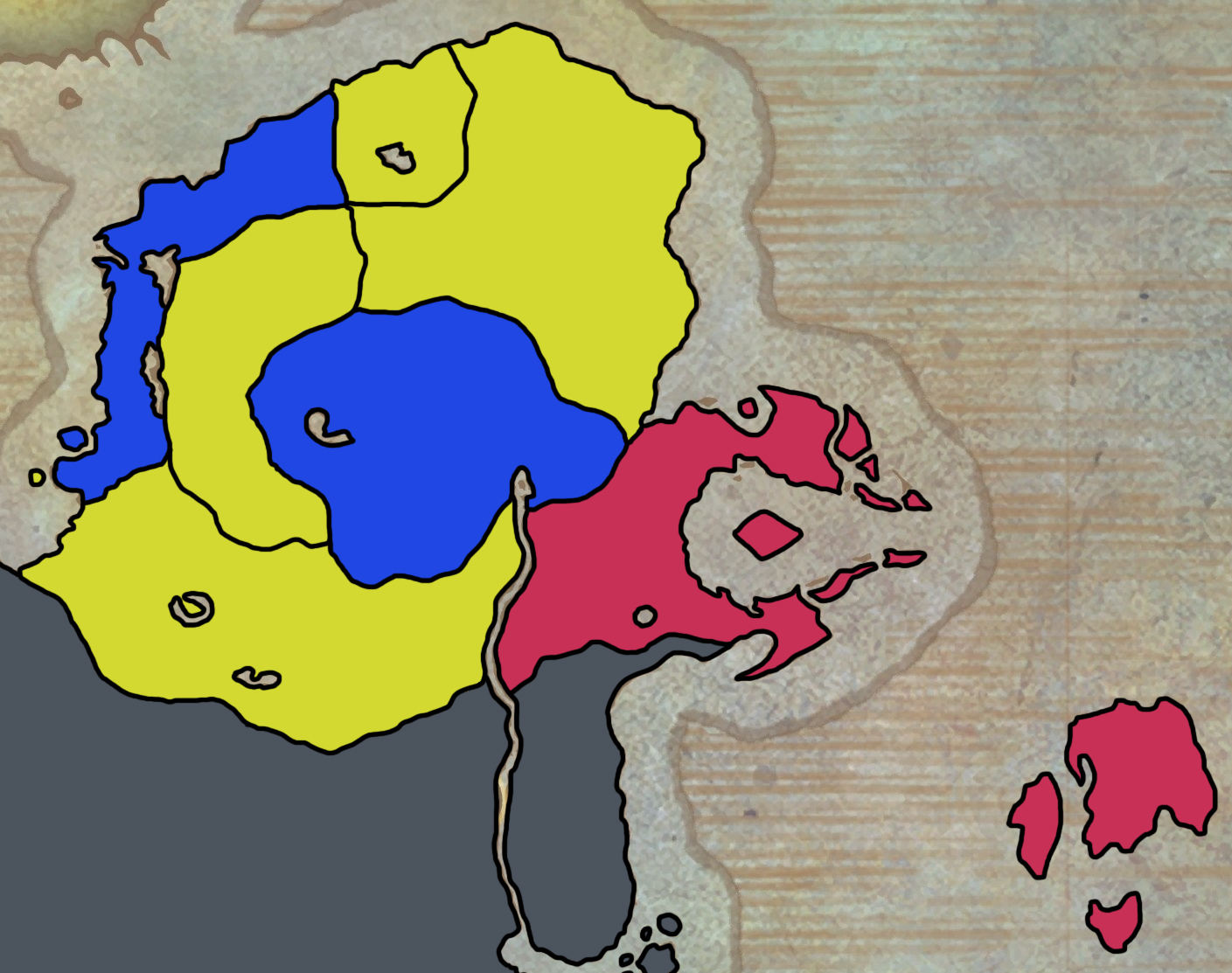It has been awhile since I did a fan expansion concept (prior to the announcement of Shadowlands in fact). I think it’s still too early to do another one, but I have a different type of fan concept I’d like to share today. Battle for Azeroth left the night elves, Forsaken, and worgen without homes, though the books Shadows Rising and Exploring Azeroth: The Eastern Kingdoms teased a future resolution for them. That they neatly fill up certain subsections of Kalimdor and the Eastern Kingdoms, and in Kalimdor’s case share it with goblins, gave me an idea.
Right now leveling for new players has them start on Exile’s Reach, then level from 10-50 in Kul Tiras and Zandalar. How exactly that will work after Shadowlands is unclear, but I’m assuming they’ll just swap out Kul Tiras and Zandalar for the Shadowlands. However this constant swapping of 10-50 content without the accompanying context behind the stories seems troublesome. So I thought, what if there was a special 10-50 leveling experience, maybe even two, created to be a timeless, self-contained storyline that could be used forever (with players still being given the choice to use other past expansions for leveling via Chromie time as well)? Why not combine that idea with new homelands for night elves, undead, and worgen (and throw in goblins since they’re right next to night elves in Azshara) to create two brand new 1-20 starting experiences for each faction, and two 20-50 leveling paths!
Upon starting a new character in this hypothetical revamp you would get to choose between two starting zones (and Exile’s Reach and the original ones) which would also choose the continent you’ll level to 50 on. This can be changed upon reaching level 10 at your faction’s primary hub on the continent. Alliance players can start at either Gilneas or Mount Hyjal, and Horde players can start in either Tirisfal Glades or The Lost Isles. Their primary hubs, a sort of miniature capital city akin to Theramore, are Gilneas City and Nordrassil for the Alliance, and Lordaeron City (the canonical name, Capital City, sounds too generic and there is some precedent for calling it Lordaeron City) and Bilgewater Harbor for the Horde.
From there, players have a 10-20 zone for their faction, and the remaining four zones to get to level 50 are all neutral, with settlements and quest-lines for both factions. I initially considered adding the blood elf and draenei starting zones as well, since they’re in the same area. However I decided against it, both to make things more realistic (after all Blizzard’s current solution is nowhere near as intricate as this even without the extra zones) and because I have a different idea for the Azuremyst Isles and Quel’thalas that I plan to use in a future expansion concept someday.
There’s one notable exemption, I didn’t include dungeons. I intentionally left them out as I wanted to focus on the zones themselves but if there’s a positive response to this idea that wants to seem them I might go back and expand it with them.
I’ll be splitting this concept into parts. Today we’ll talk about Lordaeron, with Northern Kalimdor coming next time.
Lordaeron

Except for Western Plaguelands, my choices for what zones went to what faction were informed by Exploring Azeroth: The Eastern Kingdoms. Gilneas’ current status is actually still up in the air (it doesn’t even have a chapter in the aforementioned book), but Silverpine’s chapter (which I’ll get to when covering that zone) suggests it’s probably in Alliance hands again.
Despite the tensions that may remain between the races involved, I’ve decided the stories for these zones should be mostly free of faction conflict. The point of this revamp would be to create a timeless setting akin to Classic WoW’s zones that wouldn’t need regular updating or be stuck on cliffhangers.
Gilneas: As a promising recruit of the Alliance, you have been sent to aid Gilneas against a threat from within. Something has happened to the Blackwald, the dark forest at the heart of the peninsula. It’s spreading out of control with mischievous nature spirits and feral worgen emerging from its corrupted boughs. Lord Crowley fears it may be a resurgence of the Wolf Cult. But who is leading them, and what dark magic have they unleashed?
Notes: The idea for Gilneas’ story is a mix of letting the Wolf Cult from Curse of the Worgen get to feature in-game and a partial adaptation of the Witchwood expansion for Hearthstone. The worgen’s storyline has been tied to faction conflict more specifically than any other race, so I wanted to give them an entire arc that lets them deal with themselves and other aspects of their culture, such as the nature of the worgen curse and an exploration of Gilnean druidism.
Silverpine Forest: Having successfully foiled the Wolf Cult’s plans, Lord Crowley sends you north to Silverpine Forest in search of the cult’s leadership. But beyond Pyrewood Village, Silverpine is under the control of the Bloodfang pack. Their commitment to embracing their feral nature is disturbingly similar to the Wolf Cult’s ideals, leaving you unsure of who can be trusted.
Notes: Silverpine in Exploring Azeroth: The Eastern Kingdoms gets only a single page dedicated to it. Two-thirds of that page are just a summary of the history of Shadowfang Keep. The final paragraph is the only one that goes into Silverpine’s post Fourth War state and reads as follows:
Our contact at Shadowfang Keep is Ivar Bloodfang, leader of the Bloodfang pack, and they have claimed Fenris Isle as their own. Their hatred of the undead is endless. Agents should be careful when making contact, for while they are still our allies, they are very close to feral. Ivar prowled Shadowfang many times in search of Godfrey and has rescued several valuable and historic items that are now stored in Fenris Keep. I cannot think of better protectors of such items than the Bloodfangs.
Exploring Azeroth: The Eastern Kingdoms, page 99
So Fenris Keep at the very least is in the Alliance’s control again. With no reference to what became of The Sepulcher or Forsaken High Command, I decided to give it to the worgen and have the Forsaken get a new 10-20 zone.
Tirisfal Glades: As a fledgling soldier of the Horde, you’ve been called to help the Forsaken resettle Tirisfal Glades. Remnants of the blight have inflected the flora and fauna of the region, while mindless undead raised at the Battle of Lordaeron lash out at all who approach. Meanwhile, there are whispers of activity in the abandoned Scarlet Monastery…
Notes: Again, citing Exploring Azeroth: The Eastern Kingdoms, the chapter on Tirisfal Glades states that while the Undercity is completely uninhabitable, the blight is rapidly dissipating in the Ruins of Lordaeron above. I’ve also thought the idea of the new undead city just being Undercity again while the night elves will by necessity have to get something brand new sounded a little off. So here’s my idea, they get the Ruins of Lordaeron as a fully rebuilt capital. Following from that, the theme of Tirisfal Glades becomes one of rebuilding and finding a new post-Sylvanas identity for the Forsaken.
Western Plaguelands: Tensions are at a breaking point between the Forsaken at Andorhal and the Argent Crusade in Hearthglen. Your success in Tirisfal has prompted Lillian Voss to put you in charge of currying favor with the Crusade. To make the situation even more delicate, the Barov family have trained a new generation of necromancers within Scholomance and is preparing to unleash them upon the undead and crusaders alike.
Notes: Making Western Plaguelands the undead 10-20 zone wasn’t my first choice, but I didn’t see anywhere else that fit. Hillsbrad is neutral now as Exploring Azeroth: The Eastern Kingdoms says the Alliance reclaimed Southshore and continue to hold it post Fourth War. Then I realized the Western Plaguelands gave a unique opportunity for a Horde narrative. One of the things that bugged me a lot in the Cataclysm revamp was that the Forsaken were plaguing and raising undead only a few feet away from the Argent Crusade trying to stop those same actions from the scourge, with neither side acknowledging the dissonance. So now the entire storyline of the zone is about the Forsaken and the Argent Crusade airing out those differences and finding, not exactly a peace, but an equilibrium of sorts.
Hillsbrad Foothills: Warden Stillwater has resumed his mad experiments. He and his followers have built an army of undead creatures that threaten to overwhelm Tarren Mill and the recently reclaimed Southshore. In the north, the endless conflict between the Frostwolf orcs and Stormpike dwarves has developed a new wrinkle, the the criminal organization the Syndicate seeks to rebuild Alterac and kick out the “squatters” in their territory.
Notes: Fun fact, despite being executed for crimes against the Forsaken in Cataclysm, Warden Stillwater showed up alive and well in Legion‘s pre-expansion event. I don’t just mean they forgot to remove his NPC, they even added new dialogue and scripted events with him for the Burning Legion invasions. He’s also mentioned as still alive and attacking Gilneas in the Battle for Azeroth mission table content. So rather than just brush it off as an obvious goof (which it probably was) I realized he could make a pretty good villain for an updated Hillsbrad zone. As for the Syndicate, I wanted to explore the concept of them being the remnants of the Kingdom of Alterac they’re supposed to be rather than just the bandits they’re mostly portrayed as in-game.
Arathi Highlands: Stromgarde is in the Alliance’s hands once more, but dissent is growing among the citizens. Pamphlets extolling the virtues of a “Scarlet Brotherhood” are inciting dissent and advocating for renewed hostilities with the Horde. To the east, the orcs at Hammerfell deal with their own problems. The Witherbark trolls have united with the Boulderfist ogres to take vengeance on the Horde they feel abandoned them after the Second War.
Notes: I at one point considered having this be an Alliance zone with Stromgarde as the Alliance’s mini-capital, but that would mean getting rid of Hammerfell right after it got that fancy new update in Battle for Azeroth. Also, while the Warfront update to Arathi’s appearance was nice, they went on in 8.1.5 to update Arathi Basin with an entirely new set of art assets that looked much closer to the original Arathi’s appearance. Putting these assets in Arathi Highlands would be a must for any hypothetical revamp of the area.
Hinterlands: The forest trolls and ogres’ actions in Arathi were only the beginning. Under the leadership of the Vilebranch Tribe in the Hinterlands, they plan to summon multiple loa and use their power to drive the Horde and Alliance from Lordaeron. The Wildhammer dwarves and Revantusk trolls will be the first to fall, unless a hero such as yourself comes to their assistance.
Notes: This one’s pretty self-explanatory, but I will clarify that in my fantasy Lordaeron revamp they’d update Aerie Peak to use the Wildhammer architecture from the Twilight Highlands. I have no idea why they didn’t actually do that in Cataclysm in the first place.
Eastern Plaguelands: The House of Barov’s necromancers, the Scarlet Brotherhood, and the forest trolls’ revenge all collide in the Eastern Plaguelands. The Argent Crusade is overwhelmed by their combined threat. The Cult of the Damned have taken control of the remaining scourge forces, while the Vilebranch’s remnants prepare to make their final stand at Zul’Mashar, and the Scarlet Brotherhood skulk in the ruins of Tyr’s Hand.
Notes: You may have noticed a running theme of undead and secretive organizations-slash-cults in the Lordaeron zones. I thought having a singular theme would help bring a sense of cohesion to the new leveling experience. Kalimdor has one as well, which we’ll find out about next time.










